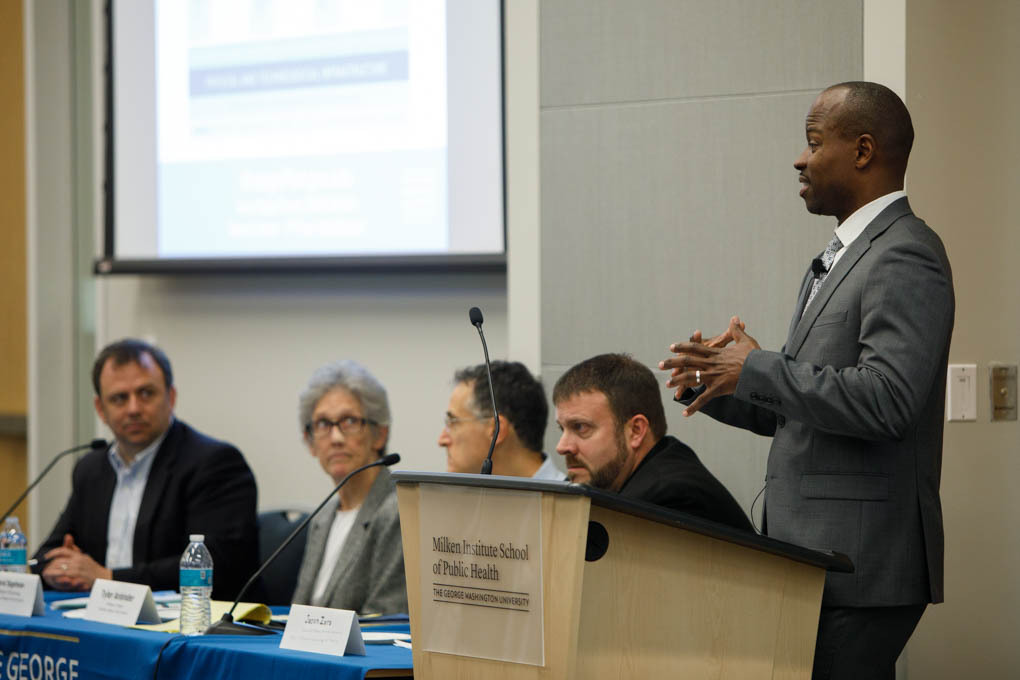The George Washington University held its second open forum on the strategic plan interim reports Wednesday, giving community members another opportunity to provide feedback on the committees’ recommendations for the university’s direction over the next five years.
The reports, which were released in January, synthesized hundreds of GW community-generated ideas. They include draft principles, metrics and recommendations for the four areas in which the university’s developing strategic plan will be focused: world-class faculty, high-quality undergraduate education, distinguished and distinctive graduate education and high-impact research.
GW Provost M. Brian Blake moderated the forum at the Milken Institute School of Public Health, which included representatives of the four faculty-led strategic planning committees. The panel solicited questions, concerns and suggestions from students, faculty and staff in the audience.
The committees will use the feedback to improve the reports this spring and will continue to share updates with the Faculty Senate, Strategic Planning Task Force and Board of Trustees.
One audience member asked for clarification about how the report measured GW’s numbers of professional doctorate degrees—those that emphasize practical use of data in a professional setting—relative to its number of academic doctorate degrees, which emphasize research skills. According to the report, GW has a relatively high number of professional doctorates compared to market basket schools.
Distinguished and Distinctive Graduate Education Committee Chair Carol Sigelman, professor of psychology in the Columbian College of Arts and Sciences, said the committee used data and metrics from the Integrated Postsecondary Education Data System (IPEDS) to distinguish the two types of doctorates, which may have overlapping features. Going forward, Dr. Sigelman said, GW will focus on meeting student and professional marketplace needs with both types of degree.
Another audience member asked about the absence of sustainability as an explicit value of the strategic plan, saying he viewed sustainability as interdisciplinary, of great student interest and central to the university’s—and the planet’s—future.
Vice Chair of the High-Quality Undergraduate Education Committee Jason Zara, associate chair for academic affairs in biomedical engineering at the School of Engineering and Applied Science, said sustainability has been a central concern in much of the feedback the committee has so far received, even constituting “about half of our conversation as a committee.” That concern will certainly be reflected in the committee’s recommendations going forward, Dr. Zara said.
Several students in the audience expressed concern about the planned 20 percent reduction in the undergraduate on-campus population at GW over the next five years. They asked whether, and how, the reduction in income from such students would affect students receiving aid, working class students, students of color and students with disabilities.
Dr. Blake said that a smaller student population would allow GW to be more flexible about how it distributes aid packages to individual students from year to year. He also pointed out that while GW may not receive income from that 20 percent of on-campus resident students, it could develop new programs based online and on other campuses to recoup that income. He added that any reduction in the population on the Foggy Bottom Campus will not come at the expense of aid for students who need it most.
An audience member said that the language around diversity in the plan and associated reports seemed generally quantitative, rather than qualitative, and asked about concrete qualitative ways GW plans to support its diverse student population.
Dr. Zara said the language was in part an effect of the metrics committees were aware of at the beginning of the planning process. He said his committee, for instance, only had metrics for retention and graduation rate—far from a comprehensive summary of the student experience. However, he said, previous forums and meetings had put the committee in touch with researchers from GW’s Graduate School of Education and Human Development, who were more familiar with assessing student experience. Dr. Zara said he hoped to be able to collaborate with these researchers as the committee moved forward.
Other audience members expressed concern about the planned increase in GW students who complete a science, technology, engineering or math (STEM) major, currently aimed to reach 30 percent. Some asked whether the shift would affect relations with alumni in fields like international relations. Others asked how students outside of STEM would continue to feel valued at the university.
Dr. Blake again stressed that the administration’s plan is to increase access to desired STEM skills for students in every discipline, while continuing to invest in GW’s fields of traditional strength.
“When we think about the university long-term, we have amazing strengths in the social sciences and humanities and public health…and we have to make sure we keep those areas extremely strong,” Dr. Blake said.
Dr. Blake encouraged the community to attend the third and final forum, which will take place 9 a.m. to 11 a.m. on March 4 in the Marvin Center Amphitheater.
All members of the GW community are urged to review the reports and provide feedback by March 6.


